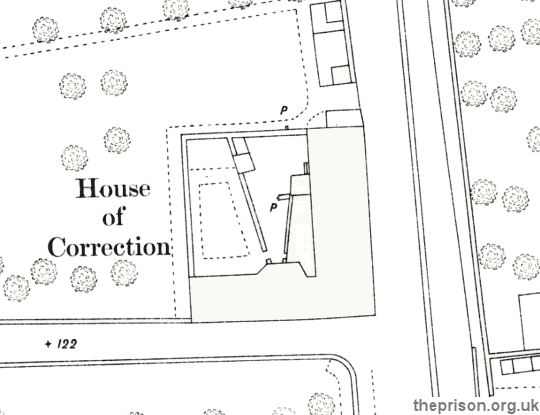County Bridewell, Hexham, Northumberland
A County Bridewell, or House of Correction was established at the junction of Tyne Green Road and Chareway Lane, Hexham, some time in the eighteenth century.
In 1818, the establishment could house up to 24 prisoners. Fourpence per day was allowed to each prisoner, who was permitted to purchase such food as he pleased. There was no uniform clothing, but apparel was furnished when absolutely necessary.
In about 1820, an extension to the building was erected on Chareway Lane. The prison site is shown on the 1861 map below.

In 1824, it was reported:
This prison has been recently enlarged, it having previously been in a very unsafe and defective condition. it is now divided into three wards, or classes, for males, females, and boys. The division for males has two day-rooms: the females have two dayrooms, and the boys have one room: an airing-yard is provided for each of these three classes, but the inspection is by no means complete. There is also a separate room for the reception of vagrants, but no yard is attached to it.
The male prisoners are employed in beating sand, unless they can be occupied in their respective trades. The women spin, knit, and sew. The number of prisoners being few, the earnings are but small: one-half is generally given to them. Each prisoner receives fourpence daily in money, in order to purchase food.
No chapel is provided, nor does any chaplain attend the prison. The keeper lends his Own Bibles and Prayer-books to the prisoners. There is no provision for instruction.
No separate apartments are provided for the sick.
Twelve prisoners was the greatest number in confinement at one time in the last year, and the number of committals during the year amounted to forty. Only one re-committal took place.
In 1838, the Inspectors of Prisons reported:
This prison stands about a quarter of a mile to the west of the town. It is ill constructed, and affords but little accommodation, there not being more than 4 or 5 rooms, and about as many cells. The place appears to be dry, and I found it tolerably clean. It is not secure, however, and an escape took place not long ago. The rooms are warmed by open fires.
There were about 5 prisoners at the time of my visit (1 female and 4 males, I think), and this, I believe, is about an average number. I understood that the health of the prisoners is, in general, tolerably good.
The discipline is of an inferior kind. Little appears to be done in the way of separation beyond the division of males from females; and the work performed is wholly unproductive. The keeper, who resides in the prison, appears to be tolerably well qualified for his situation.
The prison was closed in February 1871. Only the 1820 extension survives, now converted to private residential use.
Records
Note: many repositories impose a closure period of up to 100 years for records identifying individuals. Before travelling a long distance, always check that the records you want to consult will be available.
- Northumberland Archives, Woodhorn, Queen Elizabeth II Country Park, Ashington, Northumberland NE63 9YF. Few records survive.
- The National Archives, Kew, Richmond, Surrey, TW9 4DU. Has a wide variety of crime and prison records going back to the 1770s, including calendars of prisoners, prison registers and criminal registers.
- Find My Past has digitized many of the National Archives' prison records, including prisoner-of-war records, plus a variety of local records including Manchester, York and Plymouth. More information.
- Prison-related records on
Ancestry UK
include Prison Commission Records, 1770-1951
, and local records from London, Swansea, Gloucesterhire and West Yorkshire. More information.
- The Genealogist also has a number of National Archives' prison records. More information.
Bibliography
- Higginbotham, Peter The Prison Cookbook: A History of the English Prison and its Food (2010, The History Press)
- Brodie, A. Behind Bars - The Hidden Architecture of England's Prisons (2000, English Heritage)
- Brodie, A., Croom, J. & Davies, J.O. English Prisons: An Architectural History (2002, English Heritage)
- Harding, C., Hines, B., Ireland, R., Rawlings, P. Imprisonment in England and Wales (1985, Croom Helm)
- McConville, Sean A History of English Prison Administration: Volume I 1750-1877 (1981, Routledge & Kegan Paul)
- Morris, N. and Rothman, D.G. (eds.) The Oxfod History of the Prison (1997, OUP)
- Pugh R.B. Imprisonment in Medieval England (1968, CUP)
Links
- Prison Oracle - resources those involved in present-day UK prisons.
- GOV.UK - UK Government's information on sentencing, probation and support for families.
Except where indicated, this page () © Peter Higginbotham. Contents may not be reproduced without permission.



